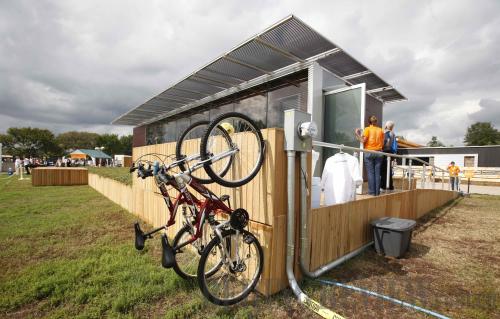|
 |
|
FUTURISTIC HOME: A solar-powered house is on display at the 2011 Solar Decathlon competition, sponsored by the U.S. Department of Energy, in Washington, D.C. (XINHUA/REUTERS) |

In spite of the impact brought on by the global financial crisis of 2008, the clean energy industry has kept a fast pace of development, as international investment in clean energy shows rapid growth. In 2010, global financing and investment related to the clean energy industry was $243 billion, increasing 30 percent over 2009. In 2011, the volume grew 5 percent more than the previous year to reach $260 billion. This volume was four times more than that of 2004, which was only $53.6 billion. The total global investment in clean energy has hit $1 trillion since 2004.
The rapid development of clean energy resources has triggered the international community's interest in a new energy revolution and expectations for an international energy transformation. However, most kinds of clean energy resources generally are still at a starting phase. It will take time to complete the transformation of the global energy structure from fossil energy to clean energy.
Humans have experienced two energy transformations: The first was from the firewood era to the coal era, which was completed around the end of the 19th century; and the second was from the coal era to the petroleum era, which was finished in the 1960s. It was not until the 1990s that the world started to pay more attention to clean energy. Since the beginning of the 21st century, the clean energy industry has undergone rapid development throughout the world.
The ongoing transformation from fossil energy to new energy and renewable energy may be the hardest revolution of human beings' energy consumption model. Unlike the previous two, people are not quite certain what energy sources can serve as alternatives to conventional fossil fuels and have yet to master related technologies. Although the general direction of the ongoing energy transformation is targeted at clean, low-carbon energy, the world is not sure which kind of energy will be the major source in the future. Hydropower, wind power, new biomass energy and geothermal energy have relatively mature technologies. These energy resources, which have price advantages but limited resources, will play a supplementary and subsidiary role. In the meantime, the technologies of solar energy, fusion power and hydrogen fuel, which have unlimited resources, have yet to mature. Therefore, the revolutionary breakthrough of the current energy transformation hasn't happened yet.
Today, clean energy occupies a small proportion of the global energy structure. According to British multinational oil and gas company BP's statistics in 2011, clean energy, including hydrogen fuel, nuclear power and renewable energy, composed only 13.09 percent of the world's total energy in 2009, and 13 percent in 2011, while the ratios for renewable energy were respectively 1.2 percent and 1.3 percent.
Technological progress leads to a lowering cost of clean energy, which has boosted clean energy's popularity in recent years. But compared to fossil energy resources, clean energy resources—except hydropower and nuclear power—are more expensive. For example, the cost of wind power, a type of clean energy with mature technology, has decreased 80 percent during the past 20 years, and 20 percent in the last five years. However, only in very few places is the price of wind power at the same level as coal electricity. A research report released by Bloomberg New Energy Finance said it won't be until 2016 when the cost of a newly built wind power station will be able to compete with that of coal power.
In general, different clean energy resources have their own shortcomings, such as a high cost, immature technological support, limited reserves, low efficiency, instability and inconveniences of transportation and usage. These are the main reasons why they cannot compete with fossil energy.
|
